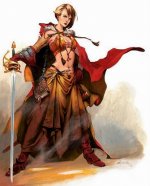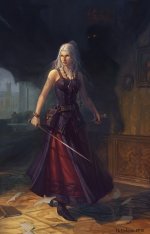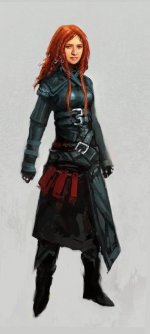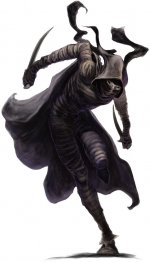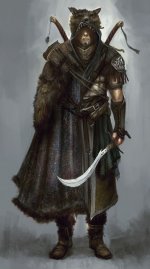You are using an out of date browser. It may not display this or other websites correctly.
You should upgrade or use an alternative browser.
You should upgrade or use an alternative browser.
D&D 5E (2024) Monks Are Not Tanks And Shouldn’t Be
- Thread starter VenerableBede
- Start date
Incenjucar
Legend
Only in that literally any class benefits from better defenses. Note that barbarians are a frontline damage role, not a tank role. Their high HP offsets that their damage method involves wading onto combat making themselves vulnerable.Maybe, but let me ask you this. What fighter would say that Evasion, proficiency in all saves, the ability to turn off charm and fear effects, immunity to poison, and resistance to all damage wouldn't make them a better frontliner?
The effect SEEMS clear in making the Monk a mage slayer, because you are assuming they are a mage slayer. But immunity to charm and fear was given to the Barbarian, and helps them stay on the frontline. Resistance to damage is a barbarian ability that lets them stay on the front line. Proficiency in all saves is just excellent for anyone, because many melee enemies can cause con saves, wis saves, even int saves.
So if we gave all of these abilties to a barbarian and a fighter, would that make them mobile mage slayers... or just more formidable front-liners against ALL foes?
The suite of abilities monks have is what WotC typically uses for assassin classes like rogues which are expected to be fairly weak to direct physical confrontations with frontline fighters and tanks, but good at ignoring the attacks of their squishier targets.
Moreover, ignoring roles, they have these defenses instead of higher hit points. In Team Fortress 2 terms, they are scouts who bounce around bonking snipers and medics to death after simply jumping over the heavy. They may need to be better at their role, or their role might not be valid in 5E and they need to be scrapped, but their suite of abilities is not subtle.
Chaosmancer
Legend
Only in that literally any class benefits from better defenses.
But, again, that is my point. All those defenses don't define the monk playstyle into being a mage slayer, because if you put them on any other class, that class doesn't actually change their combat style.
Note that barbarians are a frontline damage role, not a tank role. Their high HP offsets that their damage method involves wading onto combat making themselves vulnerable.
Barbarians are the worse damage dealers of the three major melee classes long term. Run the numbers without GWM w/Reckless attack, and the barbarian consistently falls behind. And now GWM doesn't do what it used to.
Greatsword, level 11
Barbarian: 4d6+8+6 = 28
Fighter: 6d6+12 = 33
Paladin: 4d6+2d8+8 = 31
And note, this is the barbarian using their resources, while the fighter and the Paladin are not using ANY resources. It is better at level 5, but not by a lot, and only because we are not accounting for any other resources.
Barbarian: 4d6+8+4 = 26
Fighter: 4d6+8 = 22
Paladin: 4d6+8 = 22
Now, depending on your subclass, the barbarian CAN get really good damage.. but not all of the subclasses do that. On the flip side, there is maybe only a single subclass between all the fighters and all the paladins that is as hard to kill as the Barbarian regardless of subclass. Okay, two. (Champion for regen, Eldritch Knight for Shield)
The suite of abilities monks have is what WotC typically uses for assassin classes like rogues which are expected to be fairly weak to direct physical confrontations with frontline fighters and tanks, but good at ignoring the attacks of their squishier targets.
But this is exactly the problem. Monks are a melee class. You can't get around that. Rogues CAN go into melee, but they ultimately never go into melee by themselves. Sneak attack incentivizes you to hit the same target as your own melee group. Only a rogue attempting to one-shot an enemy will ever attempt to attack from hiding on a solo target.
Rogues actually aren't assassins, they are almost combat support, because their typical move is to hit the guy being hit by their allies. Additionally, rogues are much more reliably mobile, and have much better ways to avoid being targeted at all. AND they can swap between melee and range without a drop in offense whatsoever.
Meanwhile, the plan proposed for monks is to dash behind enemy lines solo, and hit enemies that can't hit back. A monk going to hit a melee frontline enemy is in trouble ALL the time. But they are a melee class, and they lose out on a lot if they switch to range.
Moreover, ignoring roles, they have these defenses instead of higher hit points. In Team Fortress 2 terms, they are scouts who bounce around bonking snipers and medics to death after simply jumping over the heavy. They may need to be better at their role, or their role might not be valid in 5E and they need to be scrapped, but their suite of abilities is not subtle.
I think it can be agreed that, as designed, the Monk fails in their role. But I also don't think that the monk's role should be so... limited.
We always talk about the monk going and hitting squishy ranged targets, but let us compare again to the Rogue. Who is the rogue best at damaging? Everyone. If you have a ranged rogue, who has hidden themselves to get advantage, or even just uses steady aim, they can hit and deal sneak attack damage to any target on the field. Heavies? Rogues can handle them within their playstyle. Mages? Same. Artillery? Same.
But, the rogue in melee's playstyle is fundamentally to work as a team. The rogue goes in to an enemy already engaged, and hits them. That's why the rogue, with their no limit disengage, is so much more effective in melee than the monk. Because they are never trying to be a solo act. Solo rogues are almost always ranged, and rely on the frontline to keep the enemy away from them, while they hide and use cover to protect themselves against ranged retribution.
And I think this is why I want to move the monk, just a little, to be more capable as a frontliner. Because the monk is always assumed as a solo act, they don't have abilities that require teamwork like sneak attack does. And unless you have double the movement speed of your enemy, and your enemy chases you, you cannot kite in melee. It simply doesn't work. And since not every fight is going to have a a glowing weak point enemy for the monk to safely engage in melee, they need some way to deal with frontliners effectively. If they go to range, it ruins the concept of the monk. So they need to be able to stand on their own two feet here.
Incenjucar
Legend
Honestly most of the above sounds like a cascade of design failures. D&D is generally built around soft counters, but the effectiveness of those counters relies on encounter balance and optimal play actually fitting the design. While the game should allow you to build away from it, the design should make it natural for someone to lean into that intent.
I think monks actually need their hit points reduced and their other defenses made available earlier with more scaling, with a better option for burning ki to handle a high value target.
The DMG also needs to better encourage balanced encounter varieties that let all the playstyles shine.
I think monks actually need their hit points reduced and their other defenses made available earlier with more scaling, with a better option for burning ki to handle a high value target.
The DMG also needs to better encourage balanced encounter varieties that let all the playstyles shine.
doctorbadwolf
Heretic of The Seventh Circle
I can only add (for myself) the opening fight scene from Brotherhood of The Wolf, and these:I won't speak for anyone other than myself; different people have different visions of what Monks in D&D (and indeed, D&D as a whole) is or should be. But when I think "D&D Monk," my imagination goes in one of two directions:
Either this:
View attachment 289591
or this:
View attachment 289589
Not sure what that says about me as a gamer.
Attachments
Perhaps the problem is Tiers.
Think of most martial arts movies, cartoons, books, etc.
The Tier 1 beginning students, low rank ninja, or gang grunts are Skirmishers.
They jump in, do one big attack or flurry, and if that doesn't work, they flip away or get OHKOed.
The Tier 2 advanced students, special ninja gang enforcers can dip into another role. Typically Brutes and Lurkers. The Skirmishers still remain but this where the Sumos, Wrestlers, Boxers, and "Ethnic Power Attacker" appear. Along with Shuriken, Staff, and Dagger specialists appear.
So along with the flying kick people you get the big slow dude who can take a few hits to the chin and the wannabe rogues.
At Tier 3 is where the martial arts Tanks appear. This is the Hero, the Heroes Master, The Rival, The Midboss, and the Boss appear. Only Named or Famous monks get to tank. The Villain tanks everyone in the monastery. The Hero tanks everyone in the Gang Hideout.
Party party block counter typical doesn't become a trope until you are famously known for skill.
Tier 3 is also where Healer monks enter. Usually as NOCs though
Tier 4 is where all the secret and hidden techniques start cropping up and role is determined by which ones you have.
Think of most martial arts movies, cartoons, books, etc.
The Tier 1 beginning students, low rank ninja, or gang grunts are Skirmishers.
They jump in, do one big attack or flurry, and if that doesn't work, they flip away or get OHKOed.
The Tier 2 advanced students, special ninja gang enforcers can dip into another role. Typically Brutes and Lurkers. The Skirmishers still remain but this where the Sumos, Wrestlers, Boxers, and "Ethnic Power Attacker" appear. Along with Shuriken, Staff, and Dagger specialists appear.
So along with the flying kick people you get the big slow dude who can take a few hits to the chin and the wannabe rogues.
At Tier 3 is where the martial arts Tanks appear. This is the Hero, the Heroes Master, The Rival, The Midboss, and the Boss appear. Only Named or Famous monks get to tank. The Villain tanks everyone in the monastery. The Hero tanks everyone in the Gang Hideout.
Party party block counter typical doesn't become a trope until you are famously known for skill.
Tier 3 is also where Healer monks enter. Usually as NOCs though
Tier 4 is where all the secret and hidden techniques start cropping up and role is determined by which ones you have.
Clint_L
Legend
That doesn’t fit with D&D progression.Perhaps the problem is Tiers.
Think of most martial arts movies, cartoons, books, etc.
The Tier 1 beginning students, low rank ninja, or gang grunts are Skirmishers.
They jump in, do one big attack or flurry, and if that doesn't work, they flip away or get OHKOed.
The Tier 2 advanced students, special ninja gang enforcers can dip into another role. Typically Brutes and Lurkers. The Skirmishers still remain but this where the Sumos, Wrestlers, Boxers, and "Ethnic Power Attacker" appear. Along with Shuriken, Staff, and Dagger specialists appear.
So along with the flying kick people you get the big slow dude who can take a few hits to the chin and the wannabe rogues.
At Tier 3 is where the martial arts Tanks appear. This is the Hero, the Heroes Master, The Rival, The Midboss, and the Boss appear. Only Named or Famous monks get to tank. The Villain tanks everyone in the monastery. The Hero tanks everyone in the Gang Hideout.
Party party block counter typical doesn't become a trope until you are famously known for skill.
Tier 3 is also where Healer monks enter. Usually as NOCs though
Tier 4 is where all the secret and hidden techniques start cropping up and role is determined by which ones you have.
It does.That doesn’t fit with D&D progression.
The issue with D&D monks is like I said before, the path is chosen by the designers and doesn't give Players options.
- Tier 1: Skirmisher- Unarmored Defense, Unarmored Movement
- Tier2: Brute-Quickened Healing
- Tier2: Lurker- Ki-Fueled Attack
- Tier2: Skirmisher- Evasion
- Tier3: Brute
- Tier3: Healer
- Tier3: Lurker
- Tier3: Skirmisher
- Tier3: Tank
- Tier4: Brute
- Tier4: Controller
- Tier4: Healer
- Tier4: Lurker- Empty Body
- Tier4: Skirmisher
- Tier4: Tank- Perfect Defense
Charlaquin
Goblin Queen (She/Her/Hers)
Sure it does. 5e tiers are 1-4, 5-11, 12-16, and 17+That doesn’t fit with D&D progression.
Similar Threads
D&D 5E (2024)
2024 Player's Handbook reveal: "New Monk"
- Replies
- 230
- Views
- 44K
- Replies
- 16
- Views
- 2K
D&D 5E (2014)
Homebrew: AJ's 5e SAD Monk
- Replies
- 33
- Views
- 5K
- Replies
- 40
- Views
- 3K
D&D 5E (2024)
Leomunds Tiny Hut Blew Up In Their Face.
- Replies
- 20
- Views
- 2K

